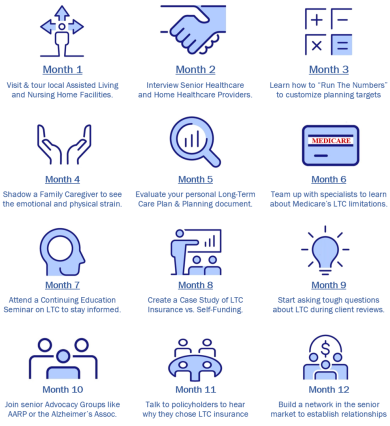12-Month Action Plan To Better Understand LTC & Planning For It
Despite its critical importance, the advisory community often overlooks or misunderstands Long-Term Care (LTC) Planning. Many advisors focus on financial preparation without fully grasping the complexities of care access, logistics, and the toll on clients and their loved ones. To better both, consider taking proactive steps with this 12-month action plan and embrace the necessity of LTC Planning. With firsthand knowledge and practical insights, you will be better positioned to integrate Healthcare In Retirement into your advisory role with clients.
Month 1: Visit and tour local Assisted Living Facilities (ALFs) or Nursing Homes (NHs) to gain a clear picture of the living conditions, levels of care, and associated costs.
Month 2: Interview Senior Healthcare Professionals and Home Healthcare Providers to discuss their experiences with families navigating care decisions and learn about emerging trends in care needs and caregiver shortages.
Month 3: Run the Numbers with tools like the Lumiant HALO Assessment to deliver data-driven, customized planning targets or the Nationwide Long-Term Care Cost Comparison Tool to calculate local LTC expenses for different levels of care (e.g., in-home care, assisted living, and nursing homes). Both will help you see how inflation and unexpected market downturns can exacerbate the financial strain of self-funding and highlight cost variances by region and care type to provide a clearer understanding of the potential financial impact.
Month 4: Shadow a Family Caregiver to see the emotional, physical, and financial strain firsthand and use these insights to communicate the risks of leaving care responsibilities unplanned.
Month 5: Evaluate Your Own LTC Plan using The Long-Term Care Plan Document as your guide.
Month 6: Collaborate with Medicare Specialists to gain clarity about Medicare’s limitations regarding LTC coverage and learn how to bridge the gap between what Medicare provides and what clients need to fund LTC. Develop expertise in framing discussions around the effectiveness of insurance in LTC planning.
Month 7: Attend a Continuing Education Seminar on LTC to stay informed about legislative updates, product innovations, and market trends, then share your knowledge with colleagues or clients to build credibility and spark meaningful conversations.
Month 8: Create a Case Study of Self-Funding vs. LTC Insurance to develop a realistic client scenario comparing the physical, emotional, and financial outcomes of self-funding versus leveraging insurance.
Month 9: Start Asking Tough Questions during client discussions to incorporate open-ended questions into client meetings, such as: “Where would you prefer to receive care if needed?” “Which of your accounts would you tap first to pay for long-term care expenses?” “How will you ensure your care preferences are honored?” These questions highlight planning gaps and create natural opportunities to discuss solutions.
Month 10: Network with Senior Advocacy Groups like AARP, the National Council on Aging (NCOA), or local aging coalitions and use these connections to position yourself as a trusted resource for families navigating care options.
Month 11: Interview LTC insurance policyholders or colleagues to understand why they chose insurance for LTC Planning, how having insurance has shaped their care decisions or reduced stress for their families, and listen to their stories to illustrate the real-life benefits of LTC Planning for hesitant clients.
Month 12: Build a Referral Network to establish relationships with local ALFs, nursing homes, geriatric care managers, and in-home care providers so you have easy access to professionals for clients when care needs arise and position yourself as a resource for families navigating care decisions, adding value to your advisory role.
Long-Term Care Planning is much more than finances—it’s about ensuring access to quality care, protecting loved ones from physical and emotional chaos, and securing dignity in the later stages of a client’s life. By following this 12-month action plan, you’ll build the knowledge, empathy, and practical expertise needed to guide your clients toward meaningful, proactive LTC solutions and truly prepare them for the future. You play a critical role in helping families navigate these challenges, but it starts with understanding the complexities of Long-Term Care.
Don't hesitate to contact us to discuss how this proactive approach will benefit your clients and set you apart as a trusted, knowledgeable advisor in a competitive landscape.

